If you are like me and prefer homemade almond milk instead of its store-bought version, you probably wondered what to do with the leftover almond pulp. Having shared so many almond flour recipes on this blog, I always wanted to know whether or not I could use the almond pulp for baking instead of the expensive almond flour.
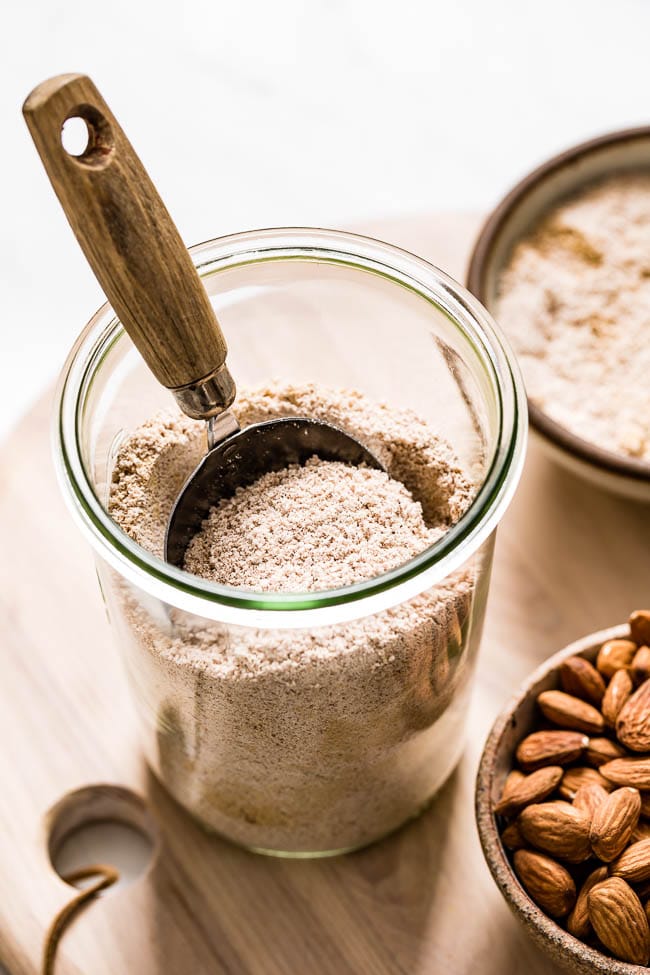
Table of Contents
- What Is Almond Pulp?
- How To Dry Out Almond Pulp?
- Why Such A Low Heat Oven?
- Can I Freeze It?
- How Long Will It Be Fresh In The Fridge?
- How To Make Almond Flour From Almond Pulp (Dried):
- How Much Almond Flour Do I Get From Using the Leftover Almond Pulp:
- How Is Almond Meal Made From Almond Pulp Different That Actual Almond Flour?
- Can I Use It In Recipes That Call Almond Meal or Almond Flour?
- Using Raw Almond Pulp in Recipes:
- Almond Pulp Recipe
I also wanted to know how would I dry, store, and use the almond pulp in my no-food-waste kitchen. If you have been there, this post is for you.
Today, we are covering everything you need to know about almond pulp along with some creative ideas to put it into good use.
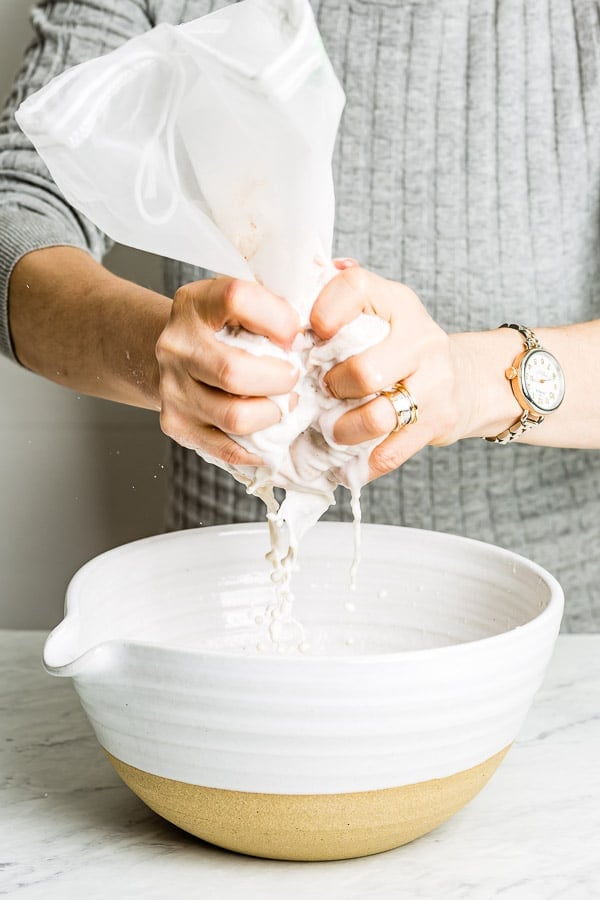
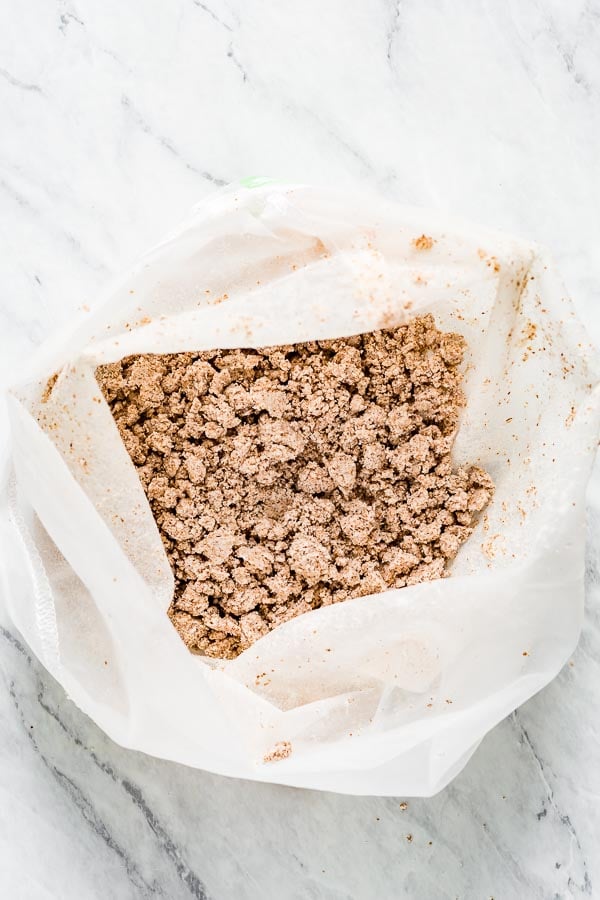
What Is Almond Pulp?
If you are not familiar, the process of making almond milk at home is quite simple. Soak almonds overnight, rinse and place them into the bowl of a blender on the next day. Add in water, blend, and strain.
The pulp you are left with after all the liquid is extracted is what we call almond pulp. Also referred to as almond paste or almond milk paste, it is the byproduct of almond milk.
After all the liquid is extracted out, at first, it looks like chunks of wet almond flour. Since it is wet, the best way to use it in recipes is to dry it out and turn it into flour using a food processor or a blender.
How To Dry Out Almond Pulp?
Before we talk about how to dry it out, I want to mention that every batch of almond pulp will differ in moisture. That is mainly because the amount of moisture depends on how much of the liquid you are able to squeeze out of the pulp.
Therefore, please use the information (and the numbers) that I am sharing here with that in mind.
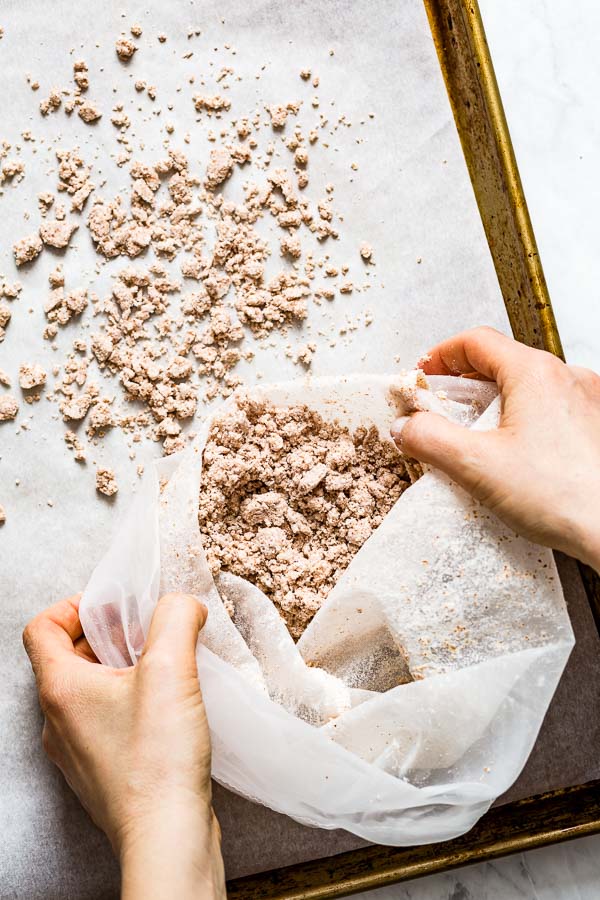
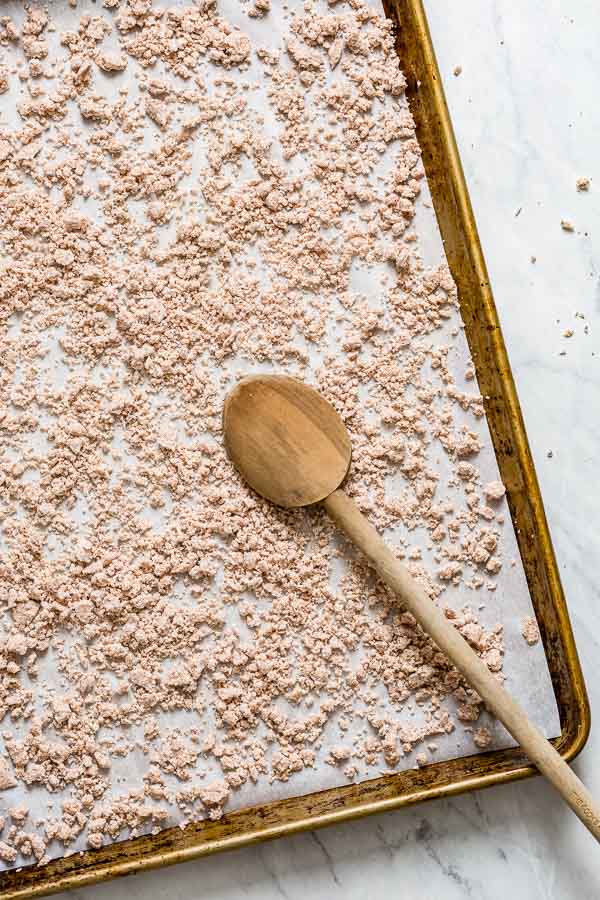
The process of drying leftover almond pulp from making almond milk is quite simple and the steps are as follows:
- Preheat the oven to 180 F degrees (82 C.). Line a baking sheet with parchment paper.
- Strain the almond milk using a nut milk bag or cheesecloth. Get as much liquid out as possible from the almonds and transfer the pulp on to the baking sheet.
- Break the wet chunks as much as you can and spread it out evenly on the baking sheet.
- Bake for 2 ½ hours, mixing and breaking the chunks every 30 minutes with a wooden spoon.
- In the end, you should be left with chunks of pulp that is dry. It should easily crumble when you crush it in between your fingers. If it is not fully dried, continue to dry for another 30 minutes by checking on it every 10 minutes or so.
As I mentioned earlier, the timing depends on how much liquid you were able to squeeze out of the nut milk bag. Obviously, the more liquid you are able to extract the quicker you’ll be able to get it dried out.
Why Such A Low Heat Oven?
I’ll be honest, I am not a big fan of keeping the oven on for such a long time. While I do not like wasting food, I also don’t care about paying a very high power bill at the end of the month.
So I tested this recipe in different temperature settings to see if I can save money by keeping the oven on for a shorter period of time. I tried 190 F (87 C) and 200 F (93 C) degrees. In both cases, I was able to shave off at least 45 minutes from drying time, but the high heat roasted the leftover pulp and changed its color (turned golden brown) and taste.
While it did not taste bad and can definitely be an option, I found that the recipes I tried with roasted almond pulp had more of that “roasted” taste compared to one that was baked low and slow.
Can I Freeze It?
If you are conscious of your power bill like I am, one solution is to collect the pulp from every batch of almond milk you make in an airtight container and freeze it to dry the out later in bigger batches. This way you can justify the cost.
I find that three batches are ideal for a large baking sheet.
Another option is to invest in a dehydrator, which is supposedly the most efficient and environmentally friendly way to dry it out. However, since I do not own one and have no experience with using it I will leave it at that.
How Long Will It Be Fresh In The Fridge?
If you don’t want to freeze almond pulp, you can store it in an airtight container in the fridge for up to 3 days.
How To Make Almond Flour From Almond Pulp (Dried):
Once the pulp is dried, place it in a high powered blender (such as Vitamix). Blend until it turns into flour. In my Vitamix, this took about 10 seconds.
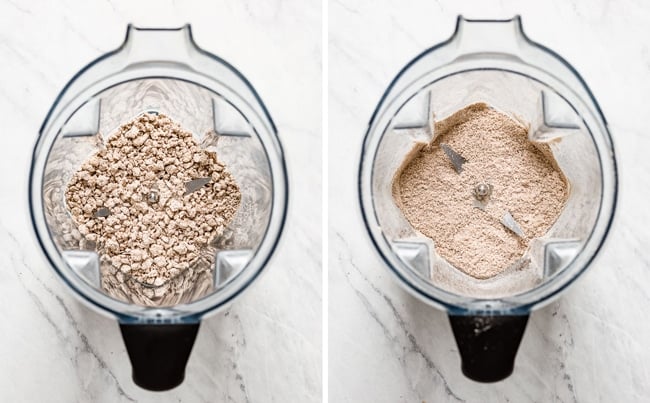
If you do not have a blender, you can also use a food processor. It might take a little longer to pulverize it but it would still work.
DID YOU KNOW? The difference between almond flour and almond meal is the type of almonds used.
What is sold as almond flour in the market today is made from blanched almonds (aka raw almonds without the skin on), whereas almond meal is made from raw almonds with the skin on.
I usually make my almond milk using raw almonds with the skin on. However, you can also make it using blanched almonds as well.
How Much Almond Flour Do I Get From Using the Leftover Almond Pulp:
Let’s talk numbers.
My go-to homemade almond milk ratio is 1 cup raw unsalted almonds soaked in water for 8 hours and then blended with 4 cups of water. For the sake of this recipe, I am not using any sweeteners (maple syrup, dates, or honey) or any other additives (vanilla or almond extract) to flavor it.
- 1 cup of raw almonds weighs ~ 5.2 ounce
- 1 cup of raw almonds soaked in water for 8 hours weighs ~ 6.8 ounce
- The leftover pulp dried out in a low-heat (180 F degree oven) for 2 ½ hours and pulverized in a blender yields a little over half a cup of almond pulp flour that is ~ 1 ounce.
How Is Almond Meal Made From Almond Pulp Different That Actual Almond Flour?
Before I provide you with almond pulp recipes and other uses of it, let’s talk about the difference between almond pulp flour and almond flour/meal (made from ground almonds):

- Weight: The first difference is the weight. 1 cup of almonds approximately makes 1 1/4 cups of almond flour. 1 cup of almond flour weighs ~ 4.2 ounces (~ 120 grams). In comparison, 1 cup of almond pulp flour made from the leftover pulp from making almond milk weighs approximately about 1.6 ounces.
As the math suggests, the difference in weight is considerably different. - Texture: Since it is stripped from most of its fat and body during the milking process, almond pulp flour is much thinner compared to almond meal/flour. Therefore, it looks more powdery compared to almond flour.
Can I Use It In Recipes That Call Almond Meal or Almond Flour?
The answer is that it depends on the recipe.
As I was preparing for this post, I tested two of my most popular almond flour recipes; Almond Flour Chocolate Cake and Almond Flour Cookies. The difference was considerably different in that the version made with almond pulp flour ended up drier and denser than the version made with almond flour.
This is not to say that it was bad, but it ended up being a different kind of chocolate cake and cookie. I’d say denser and less moist.
In their cookbook, Sweet Laurel: Recipes For Whole Food, Grain-Free Desserts (affiliate link), Laurel Gallucho & Claire Thomas, shares the following. If you are not familiar, this cookbook is all about baked goods made (mostly) with almond flour and almond meal.
When our bakery launched, California was in the middle of a historic drought. Almond prices skyrocketed and the idea of using an ingredient so drought-intolerant weighted on us as we were baking our first cakes.
Luckily, we came up with a sustainable solution. We bought the almond meal leftover from milk production and dehydrated it to make our own flour. The residual meal is quite dry, as the fat has been stripped from the almonds, so in our recipes, we like to use 50/50 mix of homemade and store-bought almond flour.
Citation: Sweet Laurel – Recipes for Whole Food, Grain-Free Desserts
In conclusion, in order to make it work, you would have to adjust the amount of liquid and fat used in the recipe to compensate for the lack of body (weight) and fat (texture) content. And perhaps, follow in the footsteps of Laurel and Claire, and use 50% nut milk pulp and 50% almond flour.
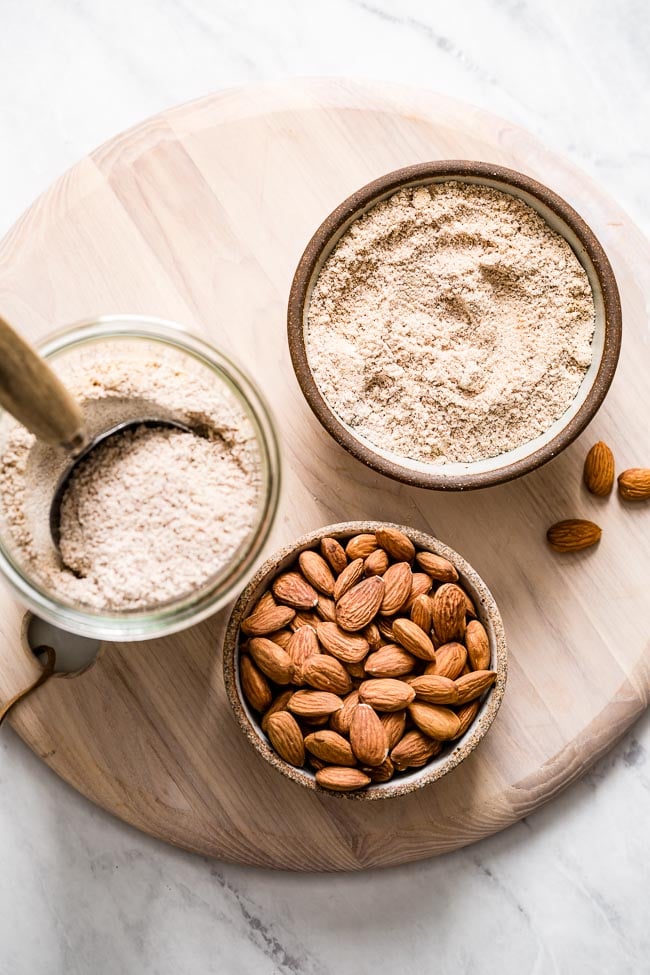
Using Raw Almond Pulp in Recipes:
The good thing is that you can use the undried raw almond pulp in so many recipes. Here are a few ideas:
- Add a few tablespoons in your breakfast smoothies: This is a really good way of adding extra fiber into your diet.
- Use it in breakfast bowls: Add in a few tablespoons of almond pul into your overnight steel-cut oatmeal or almond milk oatmeal to give them a subtle almond flavor and boost your daily fiber intake.
- Incorporate it into your energy bar recipes: Add a few tablespoons of almond pulp when you make your own kind bars or cocoa truffles for extra body and fiber.
- As Gluten-Free Alternative to Bread Crumbs: Since almonds are naturally gluten-free, its pulverized dry version makes a great substitute for gluten-free bread crumbs.
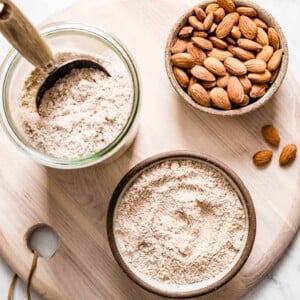
Almond Pulp Recipe
Ingredients
- 1 cup Leftover Almond Pulp from making almond milk at home
Instructions
- Preheat the oven to 180 F degrees (82 C degrees). Line a large baking sheet with parchment paper.
- Break the wet chunks as much as you can and spread it out evenly on the baking sheet.
- Bake for 2 ½ hours, mixing and breaking the chunks every 30 minutes with a wooden spoon.
- In the end, you should be left with chunks of pulp that is dry. It should easily crumble when you crush it in between your fingers. If it is not fully dried, continue to dry for another 30 minutes by checking on it every 10 minutes or so.
- Store in an airtight container in the fridge for up to 3 weeks.
Notes
- Squeeze as much liquid out as possible. The extra time you take to do so will have a direct effect on the time to dry it in the oven later.
- Alternatively you can collect the pulp from every batch of almond milk you make in an airtight container and freeze it to dry the out later in bigger batches. This way you can dry larger batches at one time and save on the energy bill. I find that three batches are ideal for a large standard size half-sheet baking sheet that is 18" x 13" x 1" high.
Nutrition
Nutrition information is automatically calculated, so should only be used as an approximation.
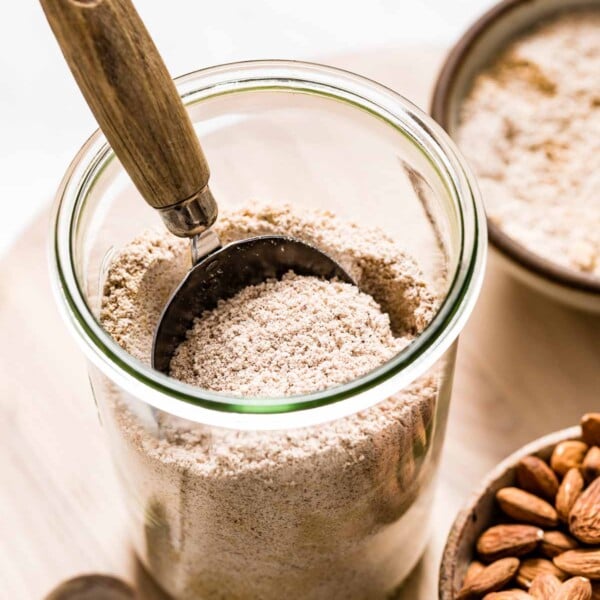
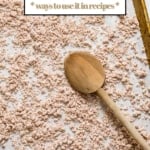
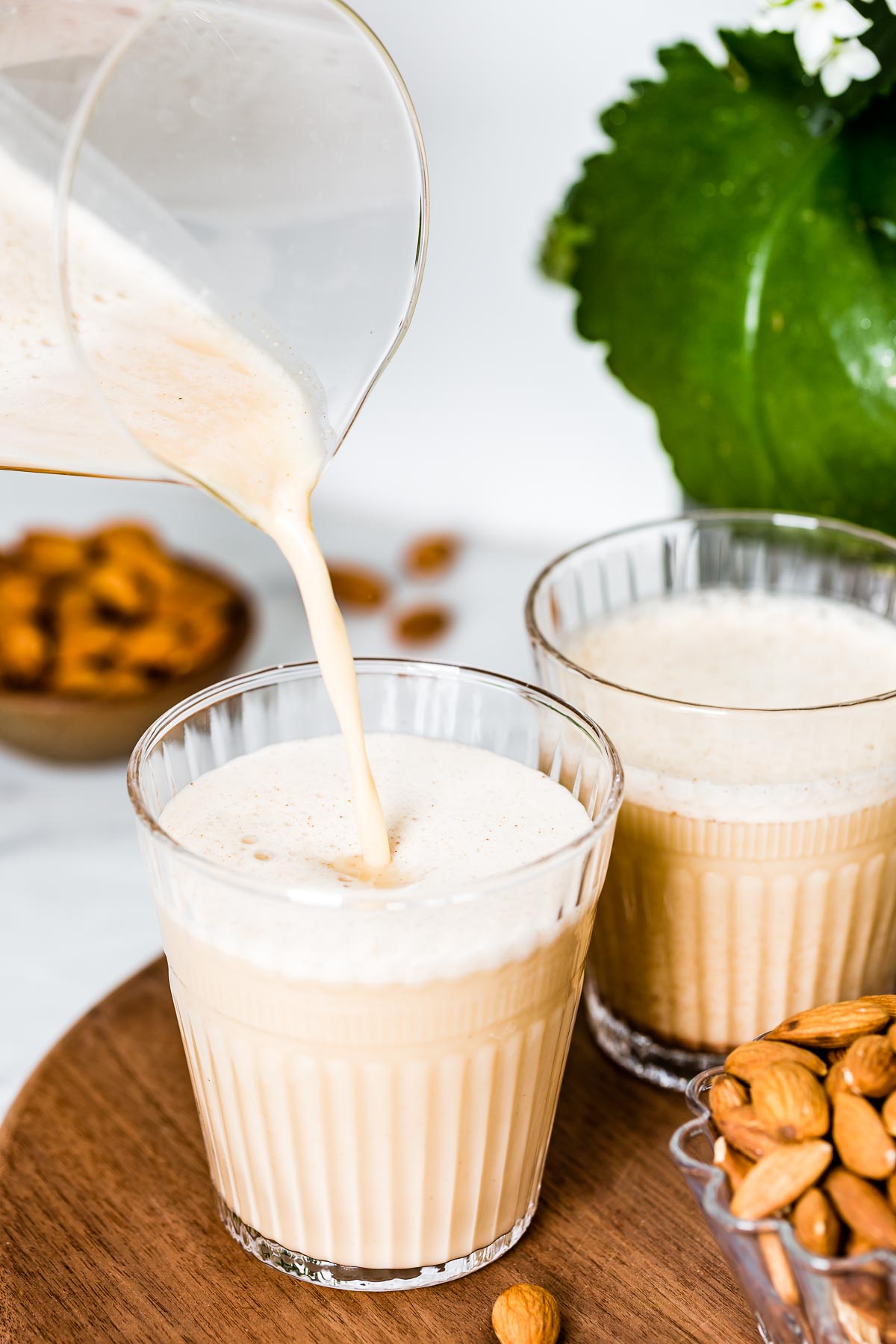












Thanks so much for your thorough investigation of this subject and sharing your findings.
You are very welcome Mary.
I have a food dehydrator. I dry my almond pulp in it, then re-blend it to make a pretty fine flour.
That is great! I have been looking into getting one myself. It is definitely useful for making almond flour using almond pulp.
Thanks for coming by Brian.
An so excited to find this page, I’ve been making almond milk for my husband and not been due what to do with the pulp… actually been feeding to the chickens but thought there must be more. Thank you. Looking forward to learning from your blog.
I am so happy you found me Helen. Please browse around and let me know if I can help you in any way.
Fabulous! I’ve been looking for easy to understand, do-able recipes for almond milk for my coffee creamer and this nails it! And of course, sparks all kinds of questions. Can I do the same thing with other nuts, like hazelnuts, brazil nuts, walnuts. And can I use the pulp like the almond flour. Thanks in advance. This has been a blast!
I am happy to hear that you liked this recipe. To be honest, I have not tried this method with other nuts. However, I do not see how it would be much different. Definitely worth giving it a try.
Would this work as a binder in my turkey loaf recipe?
Hi Amy,
That’s a good question. I have never tried it, but I think it would work.
Though please keep in mind that almonds are mostly stripped off from their fat so if it feels too dry you might want to add some fat or liquid into the mixture.
Hope this helps. I’d love to know how it turns out if you try it.
Ice
Thanks for the fabulous article. I am looking for a way to strain nutmilk that is more sanitary than hands all over the bag. (I quit making my own for that reason.) I’ll bet if anyone knows a better way, you do. Any recommendations? Thanks!
Hello Maggie,
Thanks for your sweet words. I am happy to hear that you liked this recipe.
I talked about this quite a bit in the post I wrote about How To Make Almond Milk.
In short, you can do a few things:
1. You can still use a nut milk bag but instead of using your hands, you can use the back of a spoon.
2. You can use disposable gloves
3. This is an odd one but you can use a french press. It is quite messy but it does deliver good results.
I hope these tips help. Please let me know if I can answer any other questions.
Cheers!
Aysegul
What if I make almond flour out of blanched almond pulp? I’m looking to make vegan macarons. Does the weight/texture of blanched almond pulp (made into a flour) vary greatly compared to regular almond flour?
Hi Ashley,
Good question. Blanched almond pulp is what almond flour is made of. In other words, almond flour is made from blanching almonds and pulverizing them to a superfine texture. I wrote extensively about this in my almond flour post.
Vegan macarons sound delicious. I have made macarons a few times in the past. They were not vegan but one thing that I learned during the process is that the almond flour need to be superfine for best results. If you are making your own almond flour, my recommendation is to sift it through a fine mesh strainer several times. It is a bit of extra work but definitely worth it for best results.
I hope this helps. I wish you all the best of success with vegan macarons.
Cheers,
Ice
Wow! What a thorough, detailed, insightful and well written post — very impressive … and extremely helpful! Thank you for having shared your expert knowledge!
Hi Jacinthe,
I am happy to hear that you enjoyed it. Thanks for taking the time to leave a review.
Cheers!
Very well written and searched article. I have tried some recipes using almond pulp from other blogs and they never turned out that well. Now I know why.
Thanks for all the suggestions.
I am so happy to hear that you found it helpful Samantha. Thanks for letting me know.